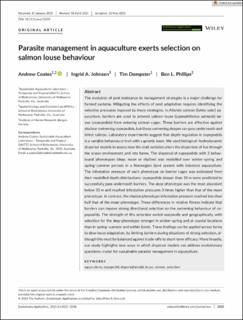| dc.description.abstract | The evolution of pest resistance to management strategies is a major challenge for farmed systems. Mitigating the effects of pest adaptation requires identifying the selective pressures imposed by these strategies. In Atlantic salmon (Salmo salar) aquaculture, barriers are used to prevent salmon louse (Lepeophtheirus salmonis) larvae (copepodids) from entering salmon cages. These barriers are effective against shallow-swimming copepodids, but those swimming deeper can pass underneath and infest salmon. Laboratory experiments suggest that depth regulation in copepodids is a variable behavioural trait with a genetic basis. We used biological–hydrodynamic dispersal models to assess how this trait variation alters the dispersion of lice through the ocean environment and into farms. The dispersal of copepodids with 3 behavioural phenotypes (deep, mean or shallow) was modelled over winter–spring and spring–summer periods in a Norwegian fjord system with intensive aquaculture. The infestation pressure of each phenotype on barrier cages was estimated from their modelled depth distributions: copepodids deeper than 10 m were predicted to successfully pass underneath barriers. The deep phenotype was the most abundant below 10 m and reached infestation pressures 3 times higher than that of the mean phenotype. In contrast, the shallow phenotype infestation pressure reached less than half that of the mean phenotype. These differences in relative fitness indicate that barriers can impose strong directional selection on the swimming behaviour of copepodids. The strength of this selection varied seasonally and geographically, with selection for the deep phenotype stronger in winter–spring and at coastal locations than in spring–summer and within fjords. These findings can be applied across farms to slow louse adaptation, by limiting barriers during situations of strong selection, although this must be balanced against trade-offs to short-term efficacy. More broadly, our study highlights new ways in which dispersal models can address evolutionary questions crucial for sustainable parasite management in aquaculture. | en_US |
